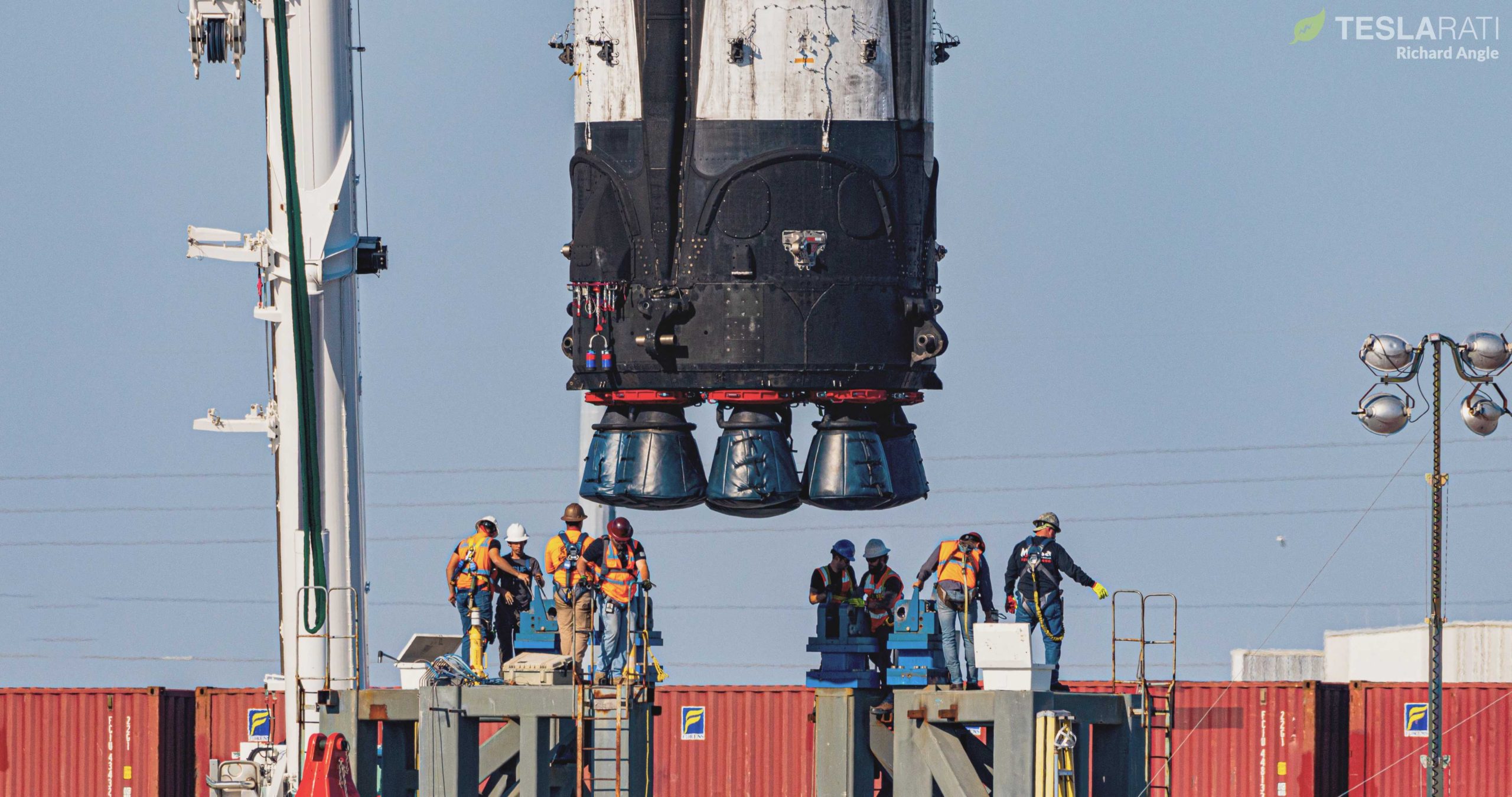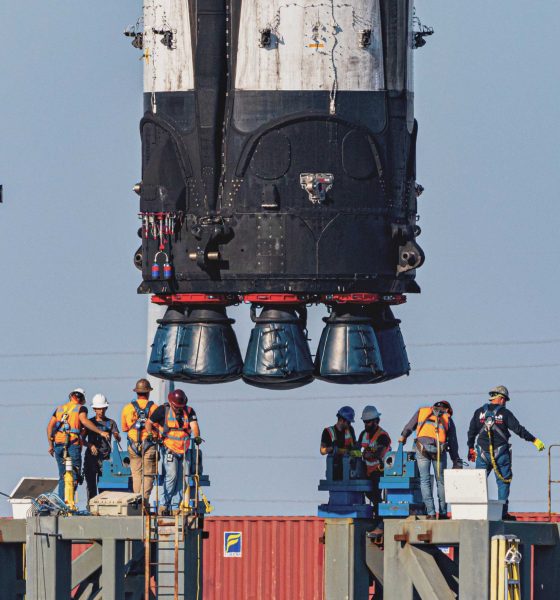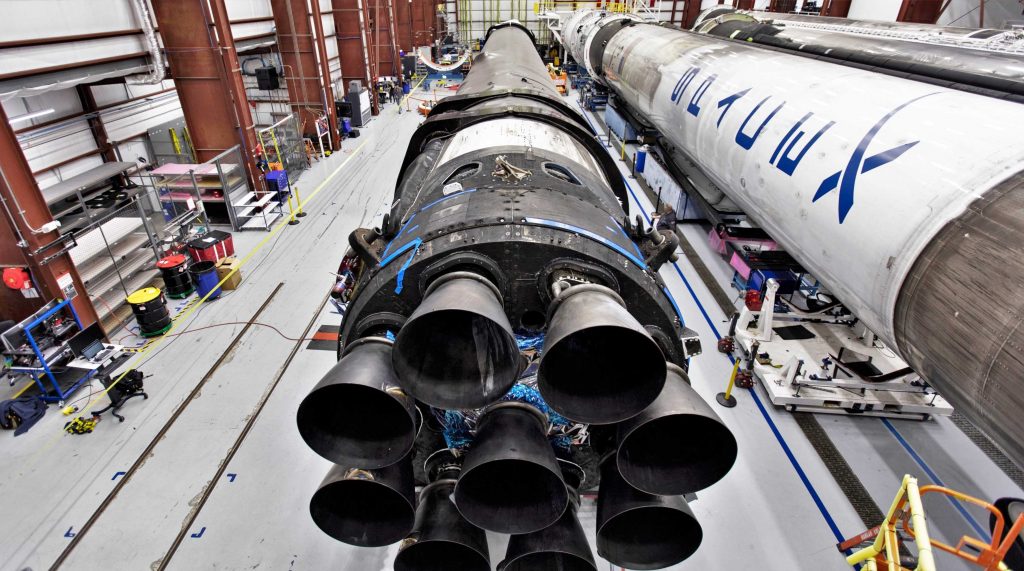

News
SpaceX skips Falcon 9 landing leg retraction on record-breaking booster
Four days after it returned to port, SpaceX quickly brought its latest recovered Falcon 9 booster horizontal, the last step before it can be transported back to one of SpaceX’s launch pad-adjacent processing facilities.
For unknown reasons, SpaceX skipped retracting its landing legs, but thanks to its recent reusability record, this particular Falcon 9 booster is now more important than ever.
On November 11th, Falcon 9 B1048 launched the 60-satellite Starlink-1 mission and became the first orbital-class SpaceX booster to fly on four separate missions. Preceded by Iridium-7 (July 2018), SAOCOM 1A (Oct 2018), and PSN-6/Nusantara Satu (Feb 2019), Starlink-1 was B1048’s (and SpaceX’s) heaviest payload ever, likely weighing around 17-18 metric tons (~39,000 lb).

Eight and a half days after Falcon 9 helped deliver all 60 satellites to an exceptionally low ~280 km (175 mi) parking orbit, all satellites have successfully deployed their solar arrays and powered on their electric thrusters, including the lone spacecraft SpaceX had concerns about prior to launch. That straggler came alive roughly 60 hours after its siblings but has since raised its orbit ~20 km, while the other 59 satellites have booster themselves by an average of 40 km (25 mi) or so.
At their current collective pace of ~5 km per day, all 60 satellites should reach their operational ~550 km (340 mi) orbits around the beginning of 2020.
Falcon 9 Block 5’s newest pathfinder
A bit less than nine minutes after its inaugural fourth launch, B1048 also became the first Falcon 9 booster to successfully land four times, coming to a halt near the center of drone ship Of Course I Still Love You (OCISLY). With its Port Canaveral processing nearly complete, B1048 now finds itself in a rare position.
As the first Falcon 9 Block 5 booster to fly four times, B1048 has first and foremost proven that the Block 5 design can be practically reused at least three times. However, the Block 5 upgrade is designed to support not just four – but at least ten – launches per booster, and SpaceX CEO Elon Musk has estimated that 100 or more launches may be achievable with more substantial routine maintenance. All this is to say that with B1048.4 safe and sound back on land, SpaceX technicians and engineers will likely pore over the booster to determine how exactly it has fared after four orbital-class launches, atmospheric reentries, and landings.
Stated a different way, B1048 is now the Block 5 upgrade’s pathfinder vehicle, meaning that it will in large part determine how SpaceX proceeds with its Falcon 9 reusability program. SpaceX has done this several times in the past – as long as the envelope is being pushed, and even if it’s not, there will always be ‘firsts’ to achieve, be it the first launch of a new rocket or the first launch of a thrice-flown booster. Prior to B1048, B1046 – also the first Falcon 9 Block 5 booster – was the pathfinder for reusability, becoming the first Block 5 booster to be reused for the first time and the second time (launch #3).

However, at the same time, Falcon 9 B1048.4 is arguably less important than it might seem. Perhaps the most useful data to be gained from the new pathfinder will involve comparing it to the likely extensively engineering data SpaceX has gathered from thrice-flown Falcon 9 boosters, including B1048 itself. Although still a fundamentally minuscule sample size in the scope of statistical significance, SpaceX has flown four (soon to be five) separate Falcon 9 boosters three times apiece.
By comparing B1048.4 to B1046.3, B1047.3, B1048.3, and B1049.3, SpaceX should be able to determine just how big the hurdle from a third launch to a fourth launch is compared to going from two launches to three launches. If the changes between those different reusability milestones are similar, it will be increasingly easy for SpaceX to rationally conclude that Falcon 9 Block 5 is fully capable of achieving its 10-flight design goal. If booster wear and tear appears to speed up from Launch 3 to 4 relative to Launch 2 to 3, design tweaks or additional refurbishment may be needed.
Most importantly, however, gathering new, high-fidelity data from flight experience like B1048’s fourth launch ultimately allows SpaceX to systematize post-flight inspections, helping technicians and engineers know where to look and what to watch out for when processing and refurbishing flight-proven boosters. The more boosters, launches, and landings there are, the more confident SpaceX can be that those systems and processes are sound.
For unknown reasons, SpaceX briefly attempted to retract Falcon 9 B1048.4’s landing legs on November 18th but abandoned retraction after a few attempts. On November 19th, technicians processed B1048 exceptionally quickly, removing its legs, breaking the booster over (rotating it to a horizontal position), and securing it on SpaceX’s transporter in barely half a day.
With recovery operations nearly complete, SpaceX can transport B1048 from Port Canaveral to Cape Canaveral, moving the booster to one of many processing and integration hangars for a thorough inspection and any necessary refurbishment. With any luck, B1048 will be ready for its fifth launch sooner than later, maybe allowing it to support SpaceX’s next dedicated Starlink launch.
Check out Teslarati’s Marketplace! We offer Tesla accessories, including for the Tesla Cybertruck and Tesla Model 3.

Elon Musk
Starlink passes 9 million active customers just weeks after hitting 8 million
The milestone highlights the accelerating growth of Starlink, which has now been adding over 20,000 new users per day.

SpaceX’s Starlink satellite internet service has continued its rapid global expansion, surpassing 9 million active customers just weeks after crossing the 8 million mark.
The milestone highlights the accelerating growth of Starlink, which has now been adding over 20,000 new users per day.
9 million customers
In a post on X, SpaceX stated that Starlink now serves over 9 million active users across 155 countries, territories, and markets. The company reached 8 million customers in early November, meaning it added roughly 1 million subscribers in under seven weeks, or about 21,275 new users on average per day.
“Starlink is connecting more than 9M active customers with high-speed internet across 155 countries, territories, and many other markets,” Starlink wrote in a post on its official X account. SpaceX President Gwynne Shotwell also celebrated the milestone on X. “A huge thank you to all of our customers and congrats to the Starlink team for such an incredible product,” she wrote.
That growth rate reflects both rising demand for broadband in underserved regions and Starlink’s expanding satellite constellation, which now includes more than 9,000 low-Earth-orbit satellites designed to deliver high-speed, low-latency internet worldwide.
Starlink’s momentum
Starlink’s momentum has been building up. SpaceX reported 4.6 million Starlink customers in December 2024, followed by 7 million by August 2025, and 8 million customers in November. Independent data also suggests Starlink usage is rising sharply, with Cloudflare reporting that global web traffic from Starlink users more than doubled in 2025, as noted in an Insider report.
Starlink’s momentum is increasingly tied to SpaceX’s broader financial outlook. Elon Musk has said the satellite network is “by far” the company’s largest revenue driver, and reports suggest SpaceX may be positioning itself for an initial public offering as soon as next year, with valuations estimated as high as $1.5 trillion. Musk has also suggested in the past that Starlink could have its own IPO in the future.
News
NVIDIA Director of Robotics: Tesla FSD v14 is the first AI to pass the “Physical Turing Test”
After testing FSD v14, Fan stated that his experience with FSD felt magical at first, but it soon started to feel like a routine.

NVIDIA Director of Robotics Jim Fan has praised Tesla’s Full Self-Driving (Supervised) v14 as the first AI to pass what he described as a “Physical Turing Test.”
After testing FSD v14, Fan stated that his experience with FSD felt magical at first, but it soon started to feel like a routine. And just like smartphones today, removing it now would “actively hurt.”
Jim Fan’s hands-on FSD v14 impressions
Fan, a leading researcher in embodied AI who is currently solving Physical AI at NVIDIA and spearheading the company’s Project GR00T initiative, noted that he actually was late to the Tesla game. He was, however, one of the first to try out FSD v14.
“I was very late to own a Tesla but among the earliest to try out FSD v14. It’s perhaps the first time I experience an AI that passes the Physical Turing Test: after a long day at work, you press a button, lay back, and couldn’t tell if a neural net or a human drove you home,” Fan wrote in a post on X.
Fan added: “Despite knowing exactly how robot learning works, I still find it magical watching the steering wheel turn by itself. First it feels surreal, next it becomes routine. Then, like the smartphone, taking it away actively hurts. This is how humanity gets rewired and glued to god-like technologies.”
The Physical Turing Test
The original Turing Test was conceived by Alan Turing in 1950, and it was aimed at determining if a machine could exhibit behavior that is equivalent to or indistinguishable from a human. By focusing on text-based conversations, the original Turing Test set a high bar for natural language processing and machine learning.
This test has been passed by today’s large language models. However, the capability to converse in a humanlike manner is a completely different challenge from performing real-world problem-solving or physical interactions. Thus, Fan introduced the Physical Turing Test, which challenges AI systems to demonstrate intelligence through physical actions.
Based on Fan’s comments, Tesla has demonstrated these intelligent physical actions with FSD v14. Elon Musk agreed with the NVIDIA executive, stating in a post on X that with FSD v14, “you can sense the sentience maturing.” Musk also praised Tesla AI, calling it the best “real-world AI” today.
News
Tesla AI team burns the Christmas midnight oil by releasing FSD v14.2.2.1
The update was released just a day after FSD v14.2.2 started rolling out to customers.

Tesla is burning the midnight oil this Christmas, with the Tesla AI team quietly rolling out Full Self-Driving (Supervised) v14.2.2.1 just a day after FSD v14.2.2 started rolling out to customers.
Tesla owner shares insights on FSD v14.2.2.1
Longtime Tesla owner and FSD tester @BLKMDL3 shared some insights following several drives with FSD v14.2.2.1 in rainy Los Angeles conditions with standing water and faded lane lines. He reported zero steering hesitation or stutter, confident lane changes, and maneuvers executed with precision that evoked the performance of Tesla’s driverless Robotaxis in Austin.
Parking performance impressed, with most spots nailed perfectly, including tight, sharp turns, in single attempts without shaky steering. One minor offset happened only due to another vehicle that was parked over the line, which FSD accommodated by a few extra inches. In rain that typically erases road markings, FSD visualized lanes and turn lines better than humans, positioning itself flawlessly when entering new streets as well.
“Took it up a dark, wet, and twisty canyon road up and down the hill tonight and it went very well as to be expected. Stayed centered in the lane, kept speed well and gives a confidence inspiring steering feel where it handles these curvy roads better than the majority of human drivers,” the Tesla owner wrote in a post on X.
Tesla’s FSD v14.2.2 update
Just a day before FSD v14.2.2.1’s release, Tesla rolled out FSD v14.2.2, which was focused on smoother real-world performance, better obstacle awareness, and precise end-of-trip routing. According to the update’s release notes, FSD v14.2.2 upgrades the vision encoder neural network with higher resolution features, enhancing detection of emergency vehicles, road obstacles, and human gestures.
New Arrival Options also allowed users to select preferred drop-off styles, such as Parking Lot, Street, Driveway, Parking Garage, or Curbside, with the navigation pin automatically adjusting to the ideal spot. Other refinements include pulling over for emergency vehicles, real-time vision-based detours for blocked roads, improved gate and debris handling, and Speed Profiles for customized driving styles.








